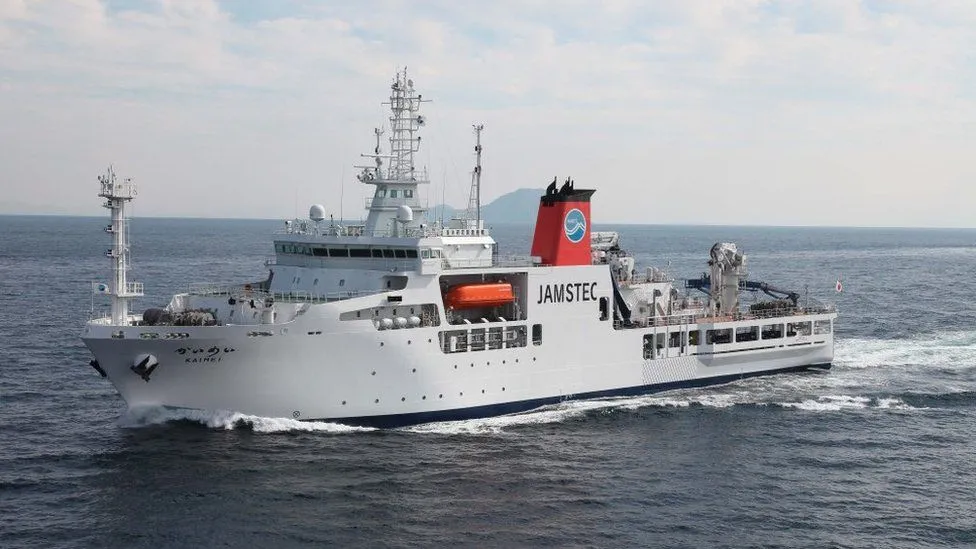Scientists just dug the deepest ocean hole in history
과학자들은 바다에 역사상 가장 깊은 구멍을 팠다.
By Brandon Specktor - Senior Writer 1 day ago
1일전 원로 작가 브랜든 스펙터씨에 의한 글
The team drilled a hole nearly 5 miles (8,000 m) below the Pacific Ocean's surface to study the region's earthquake history.
연구팀은 이 지역의 지진 역사를 연구해보기 위해 태평양
수면 아래의 거의 5마일(8,000m) 깊이에 구멍을 뚫었다.

The research vessel Kaimei cruises the Pacific Ocean near the Japan Trench. (Image credit: JAMSTEC)
탐사선 카이메이호가 일본 해구 부근의 태평양을 항행하고 있다.
(이미지 저작권: JAMSTEC)
A team of researchers working off the coast of Japan just drilled a hole in the Pacific seabed deeper than any hole in any ocean before it.
일본 해안에서 일하는 한 연구팀은 태평양 해저에 이전의
어떤 구멍보다도 더 깊은 구멍을 뚫었다.
On May 14, scientists aboard the research vessel Kaimei lowered a long, thin drill called a giant piston corer nearly 5 miles (8,000 meters) through the Pacific Ocean — waiting two hours and 40 minutes until the drill finally reached the bottom of the Japan Trench, according to a statement. There, the team extracted a 120-foot-long (37 m) sediment core from the bottom of the sea before slowly hauling the corer up again.
성명서에 의하자면, 5월 14일, 탐사선 카이메이호에 탑승한
과학자들은 태평양 아래를 통해 거의 5마일(8,000미터)지점에
거대한 피스톤 코어(corer)라고 불리는 길고 날카로운 전기
드릴을 내렸다고 하는데 --이 드릴이 일본 해구의 바닥에 도달
하는 데에 무려 2시간 40분이 걸렸다고 한다..
그곳에서 연구팀은 해저의 120피트(37m) 길이의 침전물 핵심
을 추출한 뒤 천천히 코어를 끌어올렸다.
The drill site is located very close to the epicenter of the magnitude-9.1 Tohoku-oki earthquake, which battered the region in 2011 and produced a gargantuan tsunami that smashed into the Fukushima Daiichi nuclear power plant, triggering a devastating meltdown. By studying sediment from this area, the researchers hope to learn more about the trench's ancient earthquake history.
이 실험장은 진도 9.1의 도호쿠오키 지진 진앙지와 매우 가까운
곳에 위치해 있으며, 그것은 2011년에 그 지역을 강타해서 후쿠
시마 제 1 원자력 발전소를 부수게된 거대한 쓰나미를 야기시켰다.
이 지역의 침전물을 연구함으로써, 연구원들은 바다지역의 고대
지진 역사에 대해 더 많은 것을 알기를 희망한다.
This deep drilling operation blows the previous ocean drilling record holder out of the water. For nearly 50 years, that record has belonged to the research vessel Glomar Challenger, which sunk a drill into the Mariana Trench in 1978. That operation recovered a sediment core from about 4.3 miles (7,000 m) below the surface — or about 1,000 m closer to fresh air than the recent RV Kaimei expedition, the team said.
이 깊은 드릴링 작업은 바다로부터의 이전의 해양 드릴링 기록 유지분
을 타격하게 된다.
거의 50년 동안, 그 기록은 탐사선 글로마 챌린저호에 귀속되어있었
는 데, 그것은 1978년 마리아나 해구에 구멍을 뚫은 기록치를 무너뜨
렸다.
그 작용으로는 지표면 아래 약 4.3마일(7,000m)로부터의 혹은 최근
RV 카이메이 탐사 때보다 해수면으로 약 1,000m 더 가까운 퇴적물
의 핵심을 회수한 것이었다, 고 탐사팀은 말했다
As for the deepest hole ever dug, on land or sea? That title goes to the Kola Superdeep Borehole, created by Russian scientists in the country's far northern Kola Peninsula in 1989. Drilling for the project began in 1970; nearly two decades later, the hole reached a maximum depth of 7.6 miles (12,200 m) below the surface.
육지 혹은 바다 가장 깊은 곳에 파놓은 구멍에 대해?
이 제목은 1989년 러시아 북부 콜라 반도의 러시아 과학자들에 의해
생성된 콜라 슈퍼딥 보어홀(Kola Superdeep Borehole)로 가게된다.
이 프로젝트를 위한 드릴링은 1970년에 시작되었는데, 거의 20년 더
지난 뒤 이 구멍은 표면 아래 최대 7.6마일 (12,200m) 깊이에 도달했다.
The Kola project turned up many geological samples from the continental crust — but, sadly, no buried treasure . No big loss, in the end; sometimes in Siberia, gold just falls from the sky.
Kola 프로젝트는 대륙 지각으로부터의 많은 지질학적 샘플로
나타났지만 , 안타깝게도, 묻혀진 보물은 없고, 결국은 큰 손실
도 없고. 단지 시베리아의 하늘에서 가끔 금이 떨어질뿐이다.
Originally published on Live Science.
라이브서이언스에 원본으로 출간됨

댓글 없음:
댓글 쓰기